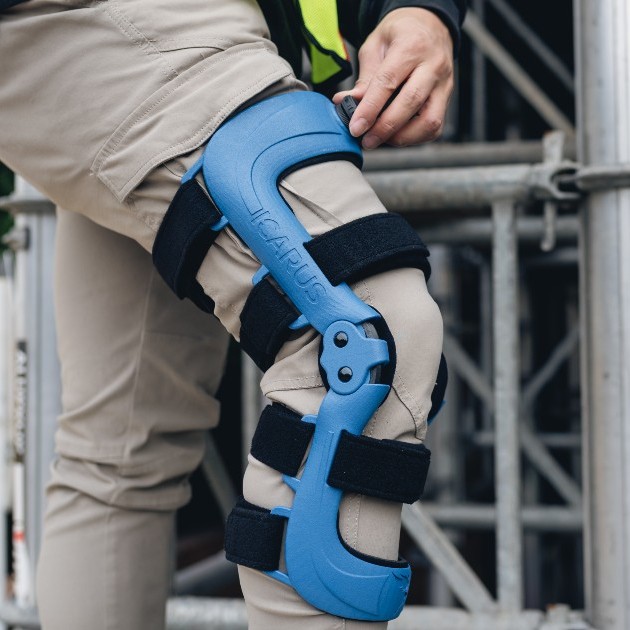The knee is the hinge that keeps us moving and the joint that holds us back. Discover the latest solutions to alleviate knee pain and keep you doing the things you love. The knee is an engineering wonder. However, in addition to being one of the most complex joints in the human body, it is also one of the most susceptible to injury. As of today, knee pain is one of the world’s most pressing health concerns. However, it doesn’t have to be a barrier to leading a fulfilling and active life.
Icarus Medical is dedicated to helping you return to the activities you love without your knee pain holding you back. It’s time to take control of your health and your life. Let us show you how. The knee can be divided into three compartments: the medial tibiofemoral compartment (TF), the lateral TF compartment, and the patellofemoral compartment (PF).
The Medial Tibiofemoral (TF)
The medial tibiofemoral (TF) compartment is the part of the knee joint that sits on the inner side of the knee, between the thigh bone (femur) and the shin bone (tibia). This compartment includes the medial meniscus and the medial collateral ligament (MCL).
The medial meniscus is a crescent-shaped piece of cartilage that acts as a shock absorber and helps to distribute weight across the joint. The MCL connects the thigh bone to the shin bone inside the knee and is critical for stability and proper alignment.
Unfortunately, the medial TF compartment is also one of the most commonly affected areas in degenerative conditions like osteoarthritis. Injuries to this area often worsen over time and can lead to pain and stiffness when extending the knee.
The Lateral Tibiofemoral (TF)
The lateral tibiofemoral compartment is a crucial part of the knee joint, located on the outer side of the knee and responsible for weight bearing and stability. Composed of the lateral meniscus and the lateral collateral ligament, this compartment plays a vital role in connecting the thigh bone (femur) to the shin bone (tibia) and ensuring proper knee function.
Unfortunately, this compartment is susceptible to lateral knee osteoarthritis, lateral meniscus tear, and lateral collateral ligament injury. These injuries can result in severe pain and difficulties with extending the knee. It is essential to be aware of these potential issues and seek proper treatment if any symptoms arise.
The Patellofemoral (PFA)
The patellofemoral compartment is the joint between the patella (knee cap) and the femur. This compartment is located in front of the knee and is the joint responsible for the movement of the kneecap. Regarding knee injuries and disorders, it’s essential to understand that different joint compartments can be affected differently.
For instance, a common knee injury is a tear in the medial meniscus. This type of injury is specific to the medial compartment and typically does not affect the lateral or patellofemoral compartments. Similarly, patellofemoral arthritis (PFA) is a condition that affects only the patellofemoral compartment.
Patellofemoral Arthritis
Patellofemoral arthritis, or PFA, is a common condition that affects the joint between the knee cap and thigh bone, known as the patellofemoral joint. It occurs when the protective cartilage cushions this joint and wears away, leading to bone-on-bone contact and causing knee pain and inflammation.
This condition is prevalent in older adults, but an injury, such as a fracture or dislocation of the patella, can also cause it. Individuals with PFA may experience mild to severe knee pain when performing everyday activities that involve bending the joint, such as squatting, sitting, walking, and climbing stairs. It’s crucial to be aware of these types of injuries and disorders and to seek proper treatment if you suspect you have one. Understanding the specific compartment affected can help guide diagnosis and treatment plans.
Statistics of Patellofemoral Pain
According to recent research, a staggering majority of patients are affected by patellofemoral anterior knee pain. A study conducted in 2016 revealed that out of a group of individuals with radiographic knee osteoarthritis (KOA), an overwhelming 94% experienced pain in the patellofemoral compartment, with only 6% experiencing it in the tibiofemoral compartment. These findings highlight the need for targeted approaches to address this specific type of knee pain and underscore the importance of proper diagnosis and treatment for those suffering from patellofemoral anterior knee pain. This is where we come in.
Why the Ascender Knee Brace?
Unlike other knee braces on the market, the Ascender is specifically designed to target and assist the patellofemoral compartment of the knee. While other knee braces work towards stabilizing the medial tibiofemoral and lateral compartments, the Ascender is one of the first braces in the healthcare industry to assist the bending and inflection of the knee directly. Other braces are great at providing support for knee extension but not for assisting knee bending and inflection. Patients with patellofemoral osteoarthritis receive little to no benefit from these traditional braces. Through 3D scans, 3D models, and 3D printing, Icarus Medical designs custom knee braces tailored to alleviate the pain associated with the patellofemoral joint.
The Ascender is the first and only dynamically unloading brace that removes up to 40 pounds of weight from the knee. During flexion, the Ascender’s multi-compartment unloading technology assists the quadriceps in drawing apart and decompressing the knee joint. By doing so, the Ascender can transfer stress from the affected joint to the brace frame. Thus, internal joint pressure is reduced, reducing knee pain and inflammation while increasing joint stability, strength, and mobility. Other braces on the market only support some of the three compartments of the joint and have significant limitations in terms of assistive force, cost, and usability. At Icarus Medical, we understand the devastating impact of knee pain all too well. That’s why we’re committed to our product and keeping your knees healthy and strong for years to come. Click here to get started.

